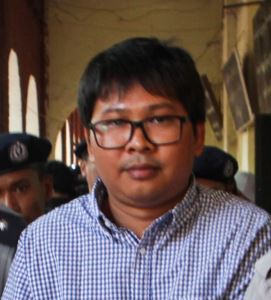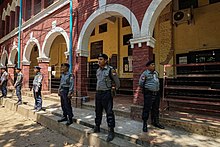In Myanmar, terrorism is defined by the country's counter-terrorism law and its subsections, which is interpreted by the Anti-Terrorism Central Committee and enforced by the government of Myanmar. Two groups are currently listed as terrorist organisations in accordance with Myanmar's counter-terrorism law; the Arakan Rohingya Salvation Army (ARSA), which was added on 25 August 2017, and the Arakan Army, which was added on 18 January 2019. The SPDC military government called the Vigorous Burmese Student Warriors (VBSW) "terrorists" after their role in the 1999 Myanmar Embassy siege, but the group was never legally declared as such.

Insurgencies have been ongoing in Myanmar since 1948, the year the country, then known as Burma, gained independence from the United Kingdom. The conflict has largely been ethnic-based, with several ethnic armed groups fighting Myanmar's armed forces, the Tatmadaw, for self-determination. Despite numerous ceasefires and the creation of autonomous self-administered zones in 2008, many armed groups continue to call for independence, increased autonomy, or the federalisation of the country. The conflict is the world's longest ongoing civil war, having spanned more than seven decades.

Insein Prison is located in Yangon Division, near Yangon (Rangoon), the old capital of Myanmar. From 1988 to 2011 it was run by the military junta of Myanmar, named the State Law and Order Restoration Council from 1988 to 2003 and the State Peace and Development Council (SPDC) from 2003 to 2011, and was used largely to repress political dissidents.

The Rohingya conflict is an ongoing conflict in the northern part of Myanmar's Rakhine State, characterised by sectarian violence between the Rohingya Muslim and Rakhine Buddhist communities, a military crackdown on Rohingya civilians by Myanmar's security forces, and militant attacks by Rohingya insurgents in Buthidaung, Maungdaw, and Rathedaung Townships, which border Bangladesh.

The Arakan Army, officially the Arakha Army is an ethnic armed organisation based in Rakhine State (Arakan). Founded on 10 April 2009, the AA is the military wing of the United League of Arakan (ULA). It is currently led by Commander-in-Chief Major General Twan Mrat Naing and vice deputy commander-in-chief Brigadier General Nyo Twan Awng. The Arakan Army states that the objective of its armed revolution is to restore the sovereignty of the Arakan people. In a February 2024 interview, Twan Mrat Naing claimed that the AA had grown to at least 38,000 troops. Anthony Davis, an expert of military and security, rejected this claim and estimated that it has at least 15,000 troops in Chin State and Rakhine State, in addition to around 1500 in Kachin State and Shan State. In the early 2010s, the Arakan Army fought alongside the Kachin Independence Army (KIA) against the Tatmadaw in the Kachin conflict. Following the 2016 outbreak of conflict in Rakhine state, AA became more heavily involved in the Arakan region. In 2019, AA would launch attacks on state security forces and the Myanmar Army would respond heightening clashes. The AA reached a ceasefire in late 2020 after eroding the central government's control in northern Rakhine. The power vacuum would be filled by the AA over the next 18 months with state-building efforts, like their COVID-19 vaccine rollouts.

The Arakan Rohingya Salvation Army (ARSA), formerly known as Harakah al-Yaqin, is a Rohingya insurgent group active in northern Rakhine State, Myanmar. According to a December 2016 report by the International Crisis Group, it is led by Ataullah abu Ammar Jununi, a Rohingya man who was born in Karachi, Pakistan, and grew up in Mecca, Saudi Arabia. Other members of its leadership include a committee of Rohingya émigrés in Saudi Arabia.

The Rohingya genocide is a series of ongoing persecutions and killings of the Muslim Rohingya people by the military of Myanmar. The genocide has consisted of two phases to date: the first was a military crackdown that occurred from October 2016 to January 2017, and the second has been occurring since August 2017. The crisis forced over a million Rohingya to flee to other countries. Most fled to Bangladesh, resulting in the creation of the world's largest refugee camp, while others escaped to India, Thailand, Malaysia, and other parts of South and Southeast Asia, where they continue to face persecution. Many other countries consider these events ethnic cleansing.
Violent clashes have been ongoing in the northern part of Myanmar's Rakhine State since October 2016. Insurgent attacks by the Arakan Rohingya Salvation Army (ARSA) have led to sectarian violence perpetrated by Myanmar's military and the local Buddhist population against predominantly Muslim Rohingya civilians. The conflict has sparked international outcry and was described as an ethnic cleansing by the United Nations High Commissioner for Human Rights. In August 2017, the situation worsened and hundreds of thousands of refugees fled Myanmar into Bangladesh, with an estimated 500,000 refugees having arrived by 27 September 2017. In January 2019, Arakan Army insurgents raided border police posts in Buthidaung Township, joining the conflict and beginning their military campaign in northern Rakhine State against the Burmese military.
The Tula Toli massacre was a mass-killing of Rohingya people that occurred during a Myanmar Army clearance operation in the village of Tula Toli, Rakhine State, near the Bangladesh–Myanmar border. According to eyewitnesses, Burmese soldiers carried out the massacre with the support of local Rakhines who also resided in the village. Eyewitnesses state that at least 200 women and 300 children were killed.

On 25 August 2017, Hindu villages in a cluster known as Kha Maung Seik in the northern Maungdaw District of Rakhine State in Myanmar were attacked and 99 Bengali Hindu villagers were massacred by Muslim insurgents from the Arakan Rohingya Salvation Army (ARSA). A month later, the Myanmar Army discovered mass graves containing the corpses of 45 Hindus, most of whom were women and children.

Inn Din is a village in northern Rakhine State, Myanmar. The village is in an area of mixed ethnicity, including Rohingya and ethnic Rakhine people. In December 2017, a mass grave with ten Rohingya men was discovered near the Inn Din cemetery. In January 2018, the Myanmar military admitted that its soldiers and Rakhine paramilitaries had killed the ten Rohingyas in September of the previous year.
Events in the year 2018 in Myanmar.
The Gu Dar Pyin massacre was a mass-killing of Rohingya people by the Myanmar Army and armed Rakhine locals that reportedly happened in the village of Gu Dar Pyin, in Rakhine State, Myanmar on 27 August 2017. According to eyewitness testimony and video evidence first reported by the Associated Press, victims of the massacre were buried in five mass graves by the Myanmar Army and burnt with acid. An official count given by the Burmese government put the death toll at ten, whilst Rohingya village elders recorded a list of 75 people who may have died in the massacre and locals estimated that up to 400 people were killed in the massacre.
Maung Maung Soe is a Burmese military officer who is a major general in the Myanmar Army.
The Maung Nu massacre was a mass-killing of Rohingya people by the Myanmar Army that reportedly happened in the village of Maung Nu, in Rakhine State, Myanmar on 27 August 2017. In February 2018, video evidence emerged allegedly showing government-contracted workers bulldozing parts of Maung Nu, with visible body bags and corpses in the footage.

Wa Lone is a Reuters journalist and children's author who, with fellow reporter Kyaw Soe Oo, was arrested on 12 December 2017 in Myanmar because of their investigation into the Inn Din massacre. A police witness testified that their arrest was a case of entrapment. It is believed to have been intended to intimidate journalists.

Kyaw Soe Oo is a Myanmar Reuters journalist who, with fellow reporter Wa Lone, was arrested on 12 December 2017 in Myanmar because of their investigation into the Inn Din massacre. A police witness testified that their arrests were a case of entrapment. It is believed their arrests were intended to intimidate journalists.

The Arakan Front Party is a political party in Myanmar seeking Arakanese self-determination and holding hardline ultranationalist, anti-Rohingya and anti-Islam stances. It was founded on 11 October 2018 by Dr. Aye Maung, former chairman of the Arakan National Party, and his colleagues, including his son Tin Maung Win.
Events in the year 2022 in Myanmar.












